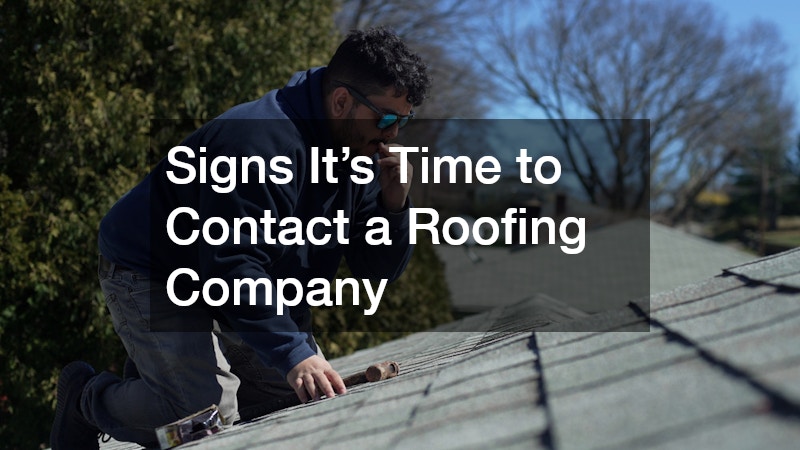In this article, we will explore the key signs that indicate it may be time to reach out to a professional roofing company for assistance. Identifying these signs early can save homeowners from costly repairs down the line. A well-maintained roof protects your home from weather damage, energy loss, and structural issues, so catching problems early is critical.
From missing or damaged shingles to leaks, sagging areas, or signs of wear around chimneys and vents, recognizing these indicators can prevent minor issues from escalating. Understanding when to contact a roofing company allows you to schedule timely inspections and repairs, ensuring your home remains safe, comfortable, and protected for years to come.
What Are the Signs of Roof Damage?
Understanding the subtle and obvious signs of roof damage to make informed decisions. Homeowners should regularly inspect their roofs both from the ground and the attic to identify any potential problems. Visible signs such as sagging sections, missing shingles, and discoloration can point to more serious issues beneath the surface.
In addition to physical signs, leaks are a major indicator that it may be time to contact a roofing company. Any water stains on ceilings or walls could signify a breach in the roof, necessitating immediate professional assessment. Neglecting to address leaks can lead to extensive water damage and mold growth, compounding repair costs.
Finally, the age of your roof plays a crucial role in determining whether you need professional help. Most roofing materials have a limited lifespan; for example, asphalt shingles last about 20-30 years. If your roof is nearing the end of its expected life, it is wise to consult with roofing experts on replacement options or repairs.
How Often Should You Have Your Roof Inspected?
An overview of the recommended frequency for roof inspections to maintain the health of your roofing system. Experts generally recommend having a professional roof inspection at least once a year. These inspections can help identify small issues before they grow into larger, more expensive problems that require immediate attention.
Another vital time for roof inspections is after severe weather events, such as heavy storms, hail, or high winds. These conditions can often compromise the integrity of your roof, making timely inspections critical to ensure no damage occurred. Early detection of potential damage can save homeowners from extensive repairs down the line.
Routine maintenance, including gutter cleaning and checking for debris, should also be paired with inspections for optimal roof health. Scheduling a comprehensive inspection every few years, even if no immediate issues are noticeable, can contribute to your roof’s overall longevity. In addition, awareness of your roofing material’s unique characteristics can guide the frequency of these inspections.
What Factors Contribute to a Roof’s Lifespan?
Discussion on various elements that impact the longevity of your roof and when you should consider replacement. Factors such as the quality of materials used during installation play a significant role in how long your roof will last. Higher-quality shingles tend to withstand the elements more effectively than lower-end options.
The installation process itself also significantly influences a roof’s durability. Improper installation can lead to premature failure and might necessitate contacting a roofing company far sooner than expected. Ensuring that the roofing professionals adhere to recommended standards is critical for maximizing your roof’s lifespan.
Moreover, regular maintenance, including inspections and timely repairs, can greatly extend your roof’s viability. By addressing issues promptly, homeowners can prevent minor problems from evolving into major repairs or replacements. Understanding these factors equips homeowners with knowledge that can help them maintain their roofs effectively over time.
How Do Weather Conditions Affect Roofing?
Insights into how different weather conditions can impact the structural integrity of your roof and when to take action. Extreme heat can cause roofing materials to deteriorate faster than cooler conditions. UV rays can break down the materials of your roof, leading to cracks and leaks over time.
Cold weather presents its own set of challenges, as freezing temperatures can lead to ice damming. This occurs when melting snow freezes at the roof’s edge, causing water to pool and leak into the attic. Homeowners in colder climates should be vigilant about monitoring their roofs during the winter months.
Lastly, heavy rainfall and storms can quickly intensify the detrimental effects on roofing. Wind conditions can displace shingles or other materials, leading to more significant vulnerabilities. Homeowners in areas prone to severe weather conditions should ensure they have a reliable roofing company on speed dial for necessary inspections post-storm.
By recognizing the signs that it’s time to contact a roofing company, homeowners can take proactive steps to ensure their roofs are well-maintained and secure. Regular inspections and awareness of potential issues can lead to significant savings and peace of mind. Understanding when to reach out for help is essential for safeguarding your home from the elements.
